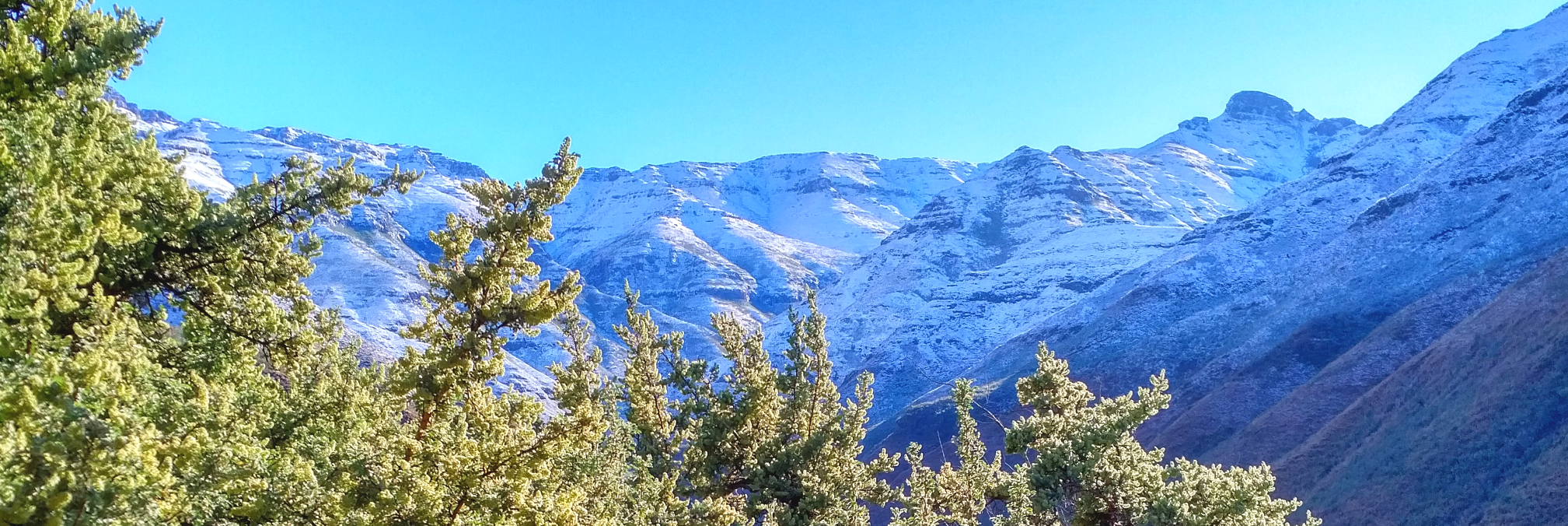
southern africa
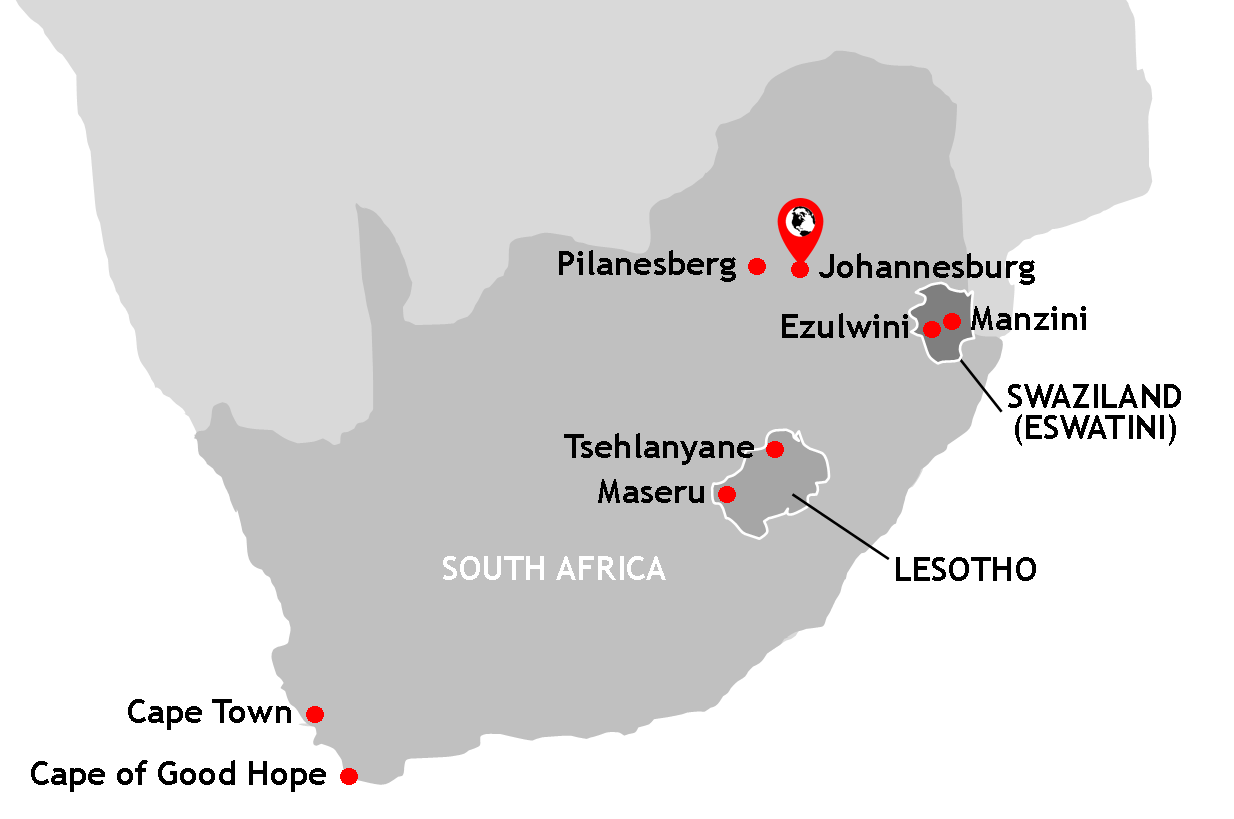
Where: Johannesburg, Pilanesberg & Cape Town, South Africa. Tsehlanyane & Maseru, Lesotho. Ezulwini & Manzini, Swaziland (Eswatini).
When: September & October 2018
What: Game drive, Witch Doctor, Local home breweries, Execution Rock, Traditional Swazi singing and dancing, Boulders penguin colony, District 6, Table Mountain, Bo-Kaap, Langa Township, Cape of Good Hope - the most south westerly part of Africa, Horse trekking.
How: International flights, Domestic flights, Transfer services, Jeep safaris, Taxis, Tour guide.
Country counter: No. 83, No.84 & No.85
Wildlife spotting: White Rhino, Zebra, Cheetah, Hyena, Giraffe, Elephant, Antelope, Springbok, Warthog, Wildebeest, Lion, Klipspringer, Ostrich, Weaver Bird, Glossy Starling, Vervet Monkey, Baboon, Penguin.
Illnesses or mishaps: Surviving the night in a cold,dark and damp riverside rondavel hut in Lesotho.
So far my experience of Africa has been limited to its Arab north, namely Morocco, which I visited in 2010, and Egypt, visited six years later with an unforgettable journey along the River Nile and beyond. Thus, this was my first experience of sub-Saharan Africa. A gruelling flight from Sydney to Johannesburg lasting over fourteen hours ranks as one of the longest non-stop flights I have had to endure so far. It was just as well, then, that we decided to make the most of it. As regular readers of this site know, I always try to maximise any trip to somewhere new by turning what could so easily be a single country trip into one involving multiple countries. A visit to South Africa, then, was an unmissable opportunity to pay a visit to the mountainous Kingdom of Lesotho, fully enclaved within South Africa, as well as the evocatively-named Swaziland on South Africa's eastern edge and also bordered by Mozambique. Tantalisingly the Mozambique capital Maputo lies just a short distance, proportionally speaking, from Swaziland but, alas, we were already short on time and realised I was getting a little travel greedy. As any person travelling around Africa will tell you, flights are expensive and countries remain frustratingly unconnected. This meant that we could not hop from one country to the next but, rather, had to fly in and out of Johannesburg several times which, ironically, we didn't even visit. Visually, then, our flight paths soon began to mimic the shape of a bicycle wheel: in out, in out, in out - with Johannesburg at the centre: frustrating, time consuming and not exactly great for the environment. Africa rewards those with a tenacious approach to travel. Accept it or fly somewhere else.
You only need to visit this trio to understand just how insulting it is to lazily lump African countries together as a single homogeneous block. Visiting South Africa, Lesotho and Swaziland in quick succession allowed me to tease out the differences and appreciate the nuances between them - more so than I ever could have if I'd have visited them individually at different times. As I was to discover, this triple Southern Africa journey would be one characterised by few similarities and many contrasts. And so, after eight flights covering three countries, clocking up nine passport stamps and spending a ludicrous 34 hours high up in the air in aluminium tubes, this was how I experienced three of southern Africa's finest.
south africa
The Rainbow Nation
True to its namesake, South Africa rests on the southern extremity of the African continent and dominates the contemporary African story. Despite its relatively small size this is a country with a monumental world story to tell. It's also a tale still being written, one where absolutely no one can guess the ending. South Africa finds itself in the eye of many storms. It is trying to unpick the seeds of hatred and division sown in its dark colonial past which has yielded such a troubling harvest of tension and distrust. It also finds itself at the centre of the AIDS epidemic and has the unenviable record of having the world's largest population of people living with the disease - a situation compounded by intractable poverty and outdated conservative attitudes to sex, mostly driven by religious dogma. More recently South Africa has also found itself at the mercy of global warming's terrifying effects, with Cape Town edging ever closer to becoming the first major city in the world to completely run out of water.
In recent years South Africa has produced some of the most powerful moments in history, the most iconic undoubtedly being Mandela's walk to freedom and subsequent scenes of celebration in his home township of Soweto beamed live around the world. Despite these scenes of joy from decades previous, I found South Africa a fractious and intense place. I can't point to any one incident in particular, just a tangible feeling that things were not right. I also couldn't shake off the feeling that there was a rather uncomfortable racial dynamic in the parts of the country I visited. I didn't like it. But I don't travel to holiday, I travel to experience and to understand - and, perhaps more importantly, to decide for myself. There is one thing for sure: nothing about South Africa is bland or forgettable. Everything is dramatic, memorable and of import. All of this makes South Africa a meaningful travel experience. This fascinating slab of land at the southern tip of Africa, the epithetic "Rainbow Nation" as Desmond Tutu was to famously proclaim, became my 83rd country.
pilanesberg
Pilanesberg is a three hour drive from Johannesburg and offered us a more probable chance of spotting iconic African wildlife known as the "Big Five" without having to head much further afield to the more famous, but also more mosquito-infested, Kruger National Park. The Big Five (buffaloes, leopards, lions, elephants and rhinos) are among the thousands of wild animals which inhabit the 550 square kilometres of extinct volcanic crater. Going on a game drive is the best way to get up close to these incredible creatures without risking life and limb - although, as I was to find, some wild animals got up pretty close on two occasions.
Barely rested from our marathon journey from Sydney to Jo'burg and three hour transfer to the national park, we set off on our game drive at 5:30am having had a matter of minutes to get ready - just enough time to fish my crumpled clothing out of the backpack and chuck a cereal bar down my neck as a poor excuse for 'breakfast'. Perhaps I'm being a little misleading here: my body was still running to Australian Standard Time and so, when the alarm beeped at 05:00am, it was actually lunchtime. It would take several days for my body clock to adjust to Central African Time. As it was, we crowded onto the safari jeep with a German couple and what I took to be a Croatian couple judging by their spoken language, and headed off into the park - bouncing all the way and with the fierce African sun rising to the east. We were assigned a woman called Jess as our game drive ranger. She was a tiny slip of a girl dressed in the full ranger regalia of khaki and baseball cap. She had her hair platted to the side and came with the thickest South African accent I think I have ever heard. She was as hard as nails and rather fantastic. I'd been extremely lucky in seeing the Proboscis monkeys in Brunei and the Orangutans on Malaysian Borneo that I dared not get my hopes up a third time. In travel it sometimes pays dividends to begin with low expectations; everything that subsequently goes right becomes a positively joyous experience.
However, it wasn't long before the beasts of Pilanesberg put on their best African performance. Over twelve hours spread across two days and three separate game drives, I'd managed to photograph white rhinos, zebras, cheetahs, hyenas, giraffes, elephants, antelopes, warthogs, wildebeest and the mighty lion - plus a whole host of other lesser-known creatures whose names I can't recall. Jess informed us of some of the wonderful collective nouns for some of these most African of creatures: a "dazzle" of zebras, a "tower" of giraffes. I also picked up some fascinating facts about animals that only a ranger would know: animal tracks always lead to water; anything you see a monkey eating humans can eat too (because of our genetic similarities); many animals have stripes to dazzle and confuse their predator thus aiding their escape. In our little jeep we had two fascinating close shaves where two of the big five, elephants and lions, got up a little too close for the comfort of our Croat friends, one of whom let out a squeal of terror when the elephant approached - a squeal Jess shut down as soon as she heard it.
My Sony camera with its zoom lens, so often relegated by the camera on my mobile phone these days, truly came into its own at Pilanesberg, allowing me to capture some impressive images of wild African animals roaming, hunting and relaxing in their natural habitat.

The view from the safari jeep.

Safari snacks with a view.
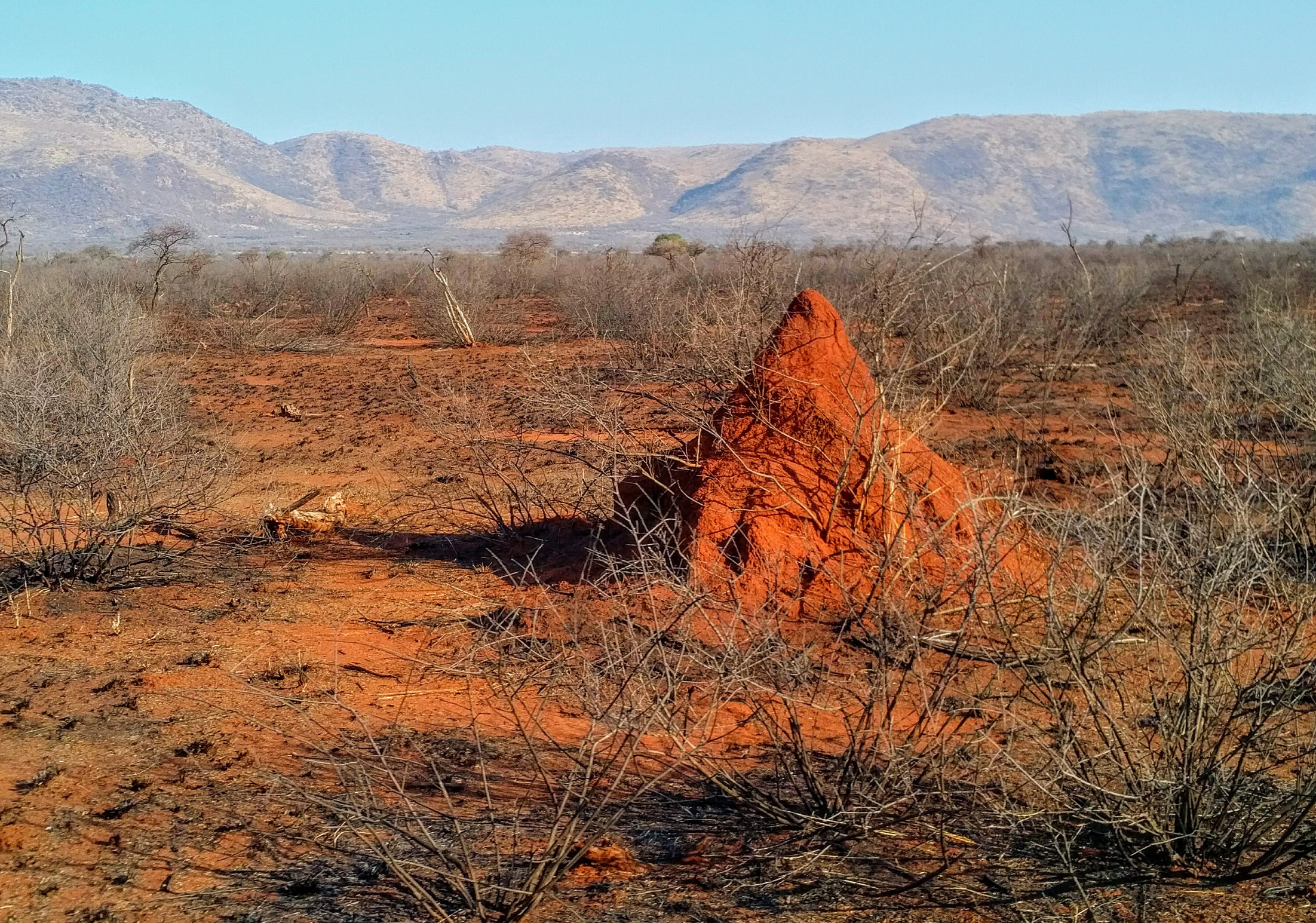
Pilanesberg landscape shot foregrounded by a termite mount.
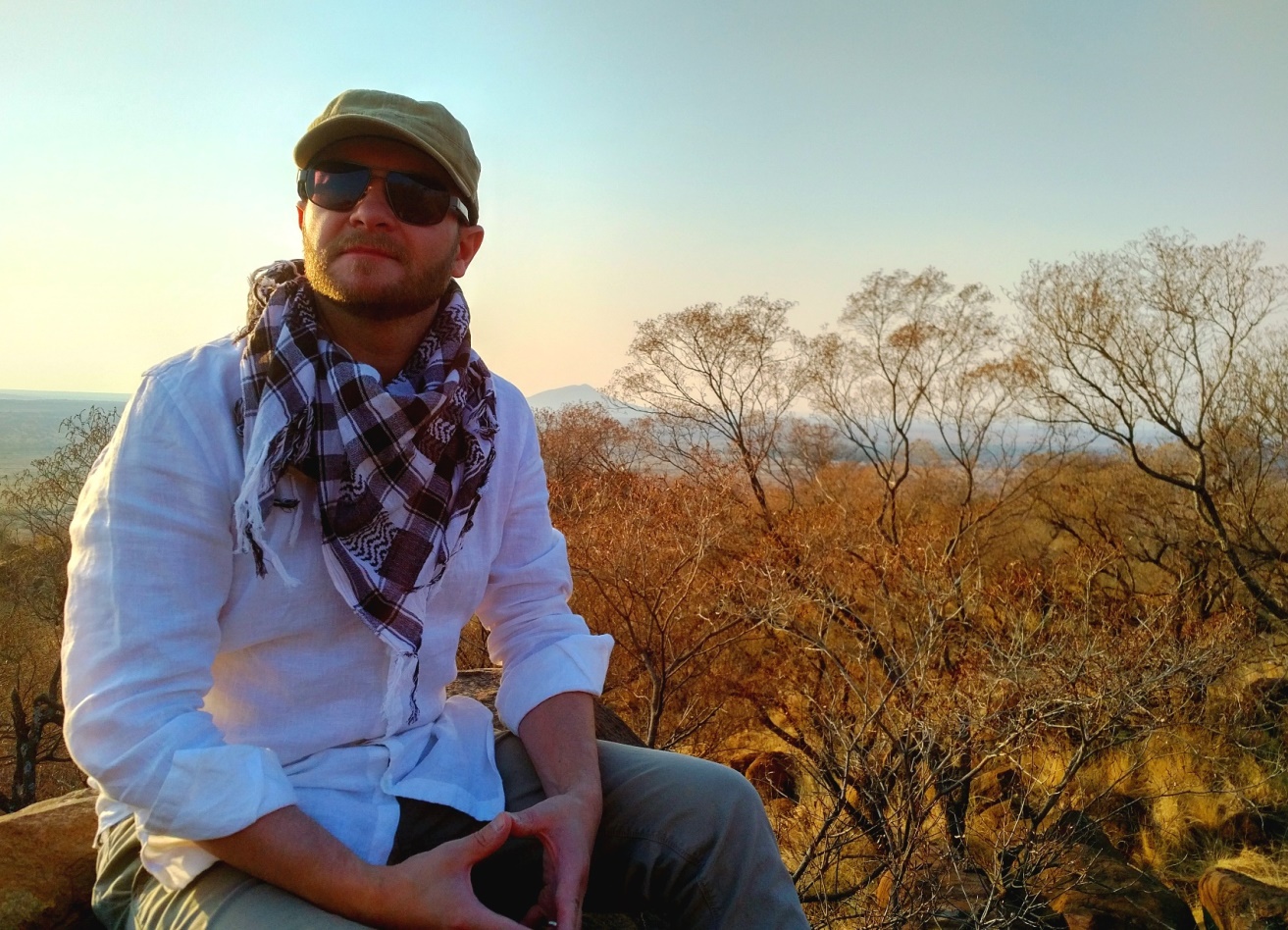
Taking the chance to savour the view of the volcanic crater just as the sun began to soften and set.
White Rhinoceros mother and baby.
A mother Elephant with her calf trotting closely behind.
My undisputed Pilanesberg favourite: a tower of Giraffes feeds on the juicy leaves high up in the tree.
A very magical Zebra darts from the watering hole.
A lioness is perfectly camouflaged in the dry grass.
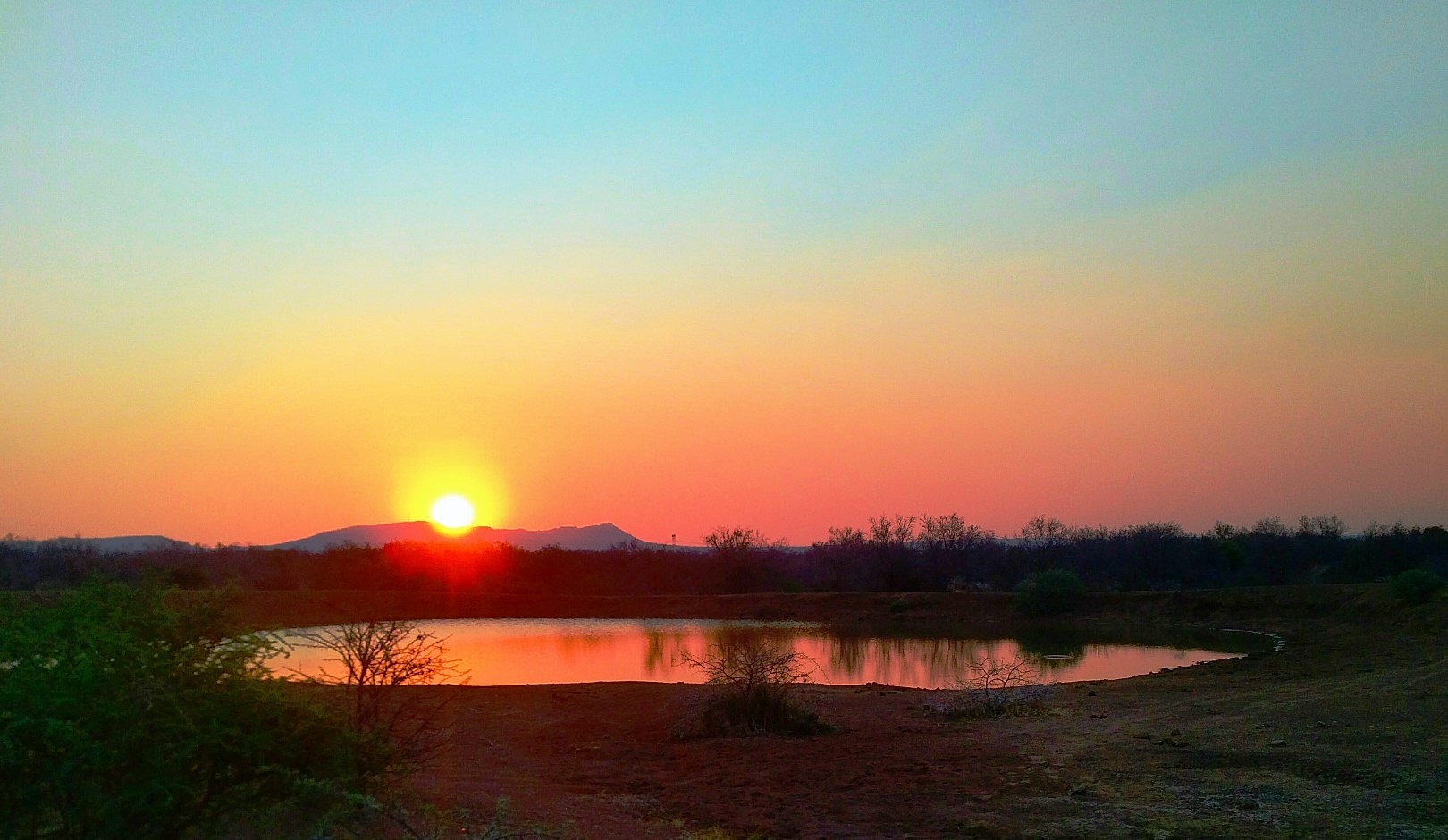
An incredible Pilanesberg sunset reflected in one of its lakes.
cape town
Cape Town looks beautiful, even impressive, from the air when you arrive in darkness. Its giant urban sprawl twinkles and sparkles at you, holding the promise of incredible city adventures. In the cold light of day, the glamour of the city seen from above and the excitement generated by the prospect of Table Mountain, are soon tempered by your experience at street level. Seen up close it is clear that Cape Town has significant issues. It has some of the poorest people I think I have ever seen (and I have been to Morocco and India amongst others). It was a city in which I just did not feel safe - so much so that we decided to make full use of the cheap taxi prices to get us about the city. Ominously, many drivers would often farewell us with a "be careful" or a "stay safe". Even Table Mountain, one of the "New7 Natural Wonders of the World" is far from immune, with regular muggings of tourists taking place up on the top of what is perhaps one of the world's most famous mountains. Indeed, a few days before our arrival a group of tourists was mugged, stripped of their clothes and one of them stabbed on this most iconic of mountains. South Africa's number one place to be isn't exactly safe for travellers to visit - with at least one attack occurring each week in the Table Mountain National Park. Then there are the smaller things you also notice which contribute towards your laissez-faire 'go with the flow' approach turning into something more like an abundance of caution: restaurants and cafés have their own bouncers standing outside, shops open for trading have their own locked gate at the entrance, and many homes are surrounded by not just high fencing but electrified fencing. As if this wasn't warning enough, what I hoped would be a gentle saunter through the city centre shopping district was overshadowed, literally, by large plumes of black, toxic smoke billowing from the city's main railway station. I was later to discover that arsonists had set fire to two train carriages waiting at a platform. According to media reports, this is happening in provinces across the country.
Our first morning was spent visiting Table Mountain. The spectacular views were uninterrupted by cloud cover - a frequent occurrence which affects many a visitor's experience. For the rest of our time in Cape Town the mountain was stubbornly topped by a hat of cloud. Unsurprisingly, Table Mountain is a tourist honey trap of the worst kind and so your experience of the place will be preceded by long queues and being crammed into a rotating cable car with seventy others. The whole set up reminded me of my time at Niagara Falls in Canada where the experience fell far short of the expectation. Add to this the fact that wanting to stray away from the tourist hordes on the mountain has the potential to result in your mugging and it's easy to see Table Mountain as one of the most underwhelming experiences in travel. Ultimately, Table Mountain is best experienced from the ground and as part of an incredible photograph you'll no doubt take of it as the dramatic backdrop to this key South African city. Moreover, from the ground looking up, the clouds enhance rather than obstruct.
A trip to South Africa would not be complete without putting yourself out there and experiencing the legacy apartheid for yourself; South Africa is not all about penguins and game drives. We had a little time left and so squeezed in a walking tour of Langa Township, the oldest township in Cape Town. It really is not safe to go snooping around townships on your own as there is a strong likelihood that you'll get into trouble. A tour with a local guide who lives in the area is the only way to experience the lives of people in a South African township from a position of relative safety. We made it to the newly-opened cultural centre in the heart of Langa and things already felt decidedly menacing with our driver bidding us farewell with an unsettling, "be careful guys" as we disembarked. We were paired up with Namhla, a young lady who lives in Langa and to whom local kids were drawn to for a cuddle and supportive squeeze. Our first stop was a small piece of scrubland home to several shipping container homes with colourful laundry gently blowing in the breeze. A local woman sat outside washing hers by hand with the help of a bucket. We went inside one of these metal boxes which some have no other option but to call home: a terrifying spaghetti junction of cables fizzed and crackled at the entrance; a pan bubbled on the portable hob; a cockroach crawled across the dresser. Two children sat outside on the 'doorstep', a wooden pallet, doing their homework and playing cards.
We pressed on to visit the local 'public house', without doubt the dingiest and most depressing space created by man. Five to six men sat on wooden stools amid a mud floor and timber walls, their faces enveloped by the darkness of the shack in which we sat. They observed us coolly as they passed around their drinking bucket containing the local brew (no individual cups is a symbolic, communal gesture representative of sharing what you have). One man in particular was passed by as the bucket from which others drank deliberately missed him out; he'd clearly had too much already and was behaving erratically. We were offered a chance to partake in the tasting but I politely declined as I knew it had been produced within these very walls and thus questioned my stomach's ability to deal with it. I satisfied myself with a sniff of the bucket and pretended, performance-wise, that I was impressed by the aroma. I wasn't. It was during this experience that I was more lucidly aware of the dynamic now operating. Thoughts of 'rich Westerner observes the African poor', 'slum tourism' and 'poverty porn' flashed through my mind. I looked down at the ground and at my feet and found some comfort in the fact that I was wearing a particularly dirty and worn pair of trainers. I was also glad that I had chosen to bring my plastic watch (worth about $2) from the dollar store rather than my other watch worth nearly one hundred times this amount. I am glad that I followed the advice of others to 'dress down' on my trip around southern Africa and would advise others to do the same. Namhla reassured us that our visit was, indeed, of great benefit to the township, not only providing her with employment but bringing in cold, hard Rand straight into the heart of the community. She also pointed out that such townships relish the chance to tell their difficult story and that locals see us as people coming to learn and understand, rather than just gawp and go.
With the drunk guy's protestations becoming ever more vociferous we excited the pub and crossed the road to a truly dismal and fetid scene: two women squatted over tree stumps, grappling sheep heads in their hands to which they pressed heated metal implements to scorch the heads ready for eating. A row of sheep heads behind them awaited a similar fate. Namhla assured us this was a local delicacy and was Langa's version of "KFC", and went on to detail that the brains are also removed as part of this process because Langans "believe that if you eat the brains of a sheep, you will end up behaving like a sheep - and no-one in the township wants that!" Smoke filled this macabre and medieval of scenes which was fascinating culturally but truly stomach-churning to behold nonetheless. The tour ended on a more positive note as we were shown more affluent areas of the township, with the area of brick-built homes christened "Beverley Hills" by locals. On several occasions we were accosted by small local children who took to embracing us at knee-level, seeking affection, high-fives and some attention. A visit to Langa was humbling, shocking and outlined in the starkest of ways that Apartheid isn't a thing of the past, but one very much part of South Africa's present.
A symbol and reminder of the destruction of a community under apartheid and the forced 'resettlement' of people based on their race is the famous District Six. After teaching Tatumkhula Afrika's poem Nothing's Changed to GCSE students for close to a decade I felt compelled to pay this place a visit - even if it is pretty much a car park now and sliced in half by two separate Cape Town districts. A mural of Nelson Mandela and a few other clues allude to its powerful contribution to the South Africa story. My visit to District Six was a powerful moment of synchronicity for me: I would never have guessed, as a naïve teacher in my early twenties teaching students in northern England about apartheid through Afrika's poem, that I would one day be stood in District Six itself. The giant mural of Mandela looked down at me and the lines of the poem resurfaced afresh after so many years lying dormant somewhere at the back of my mind: "Small round hard stones, click under my heels...".
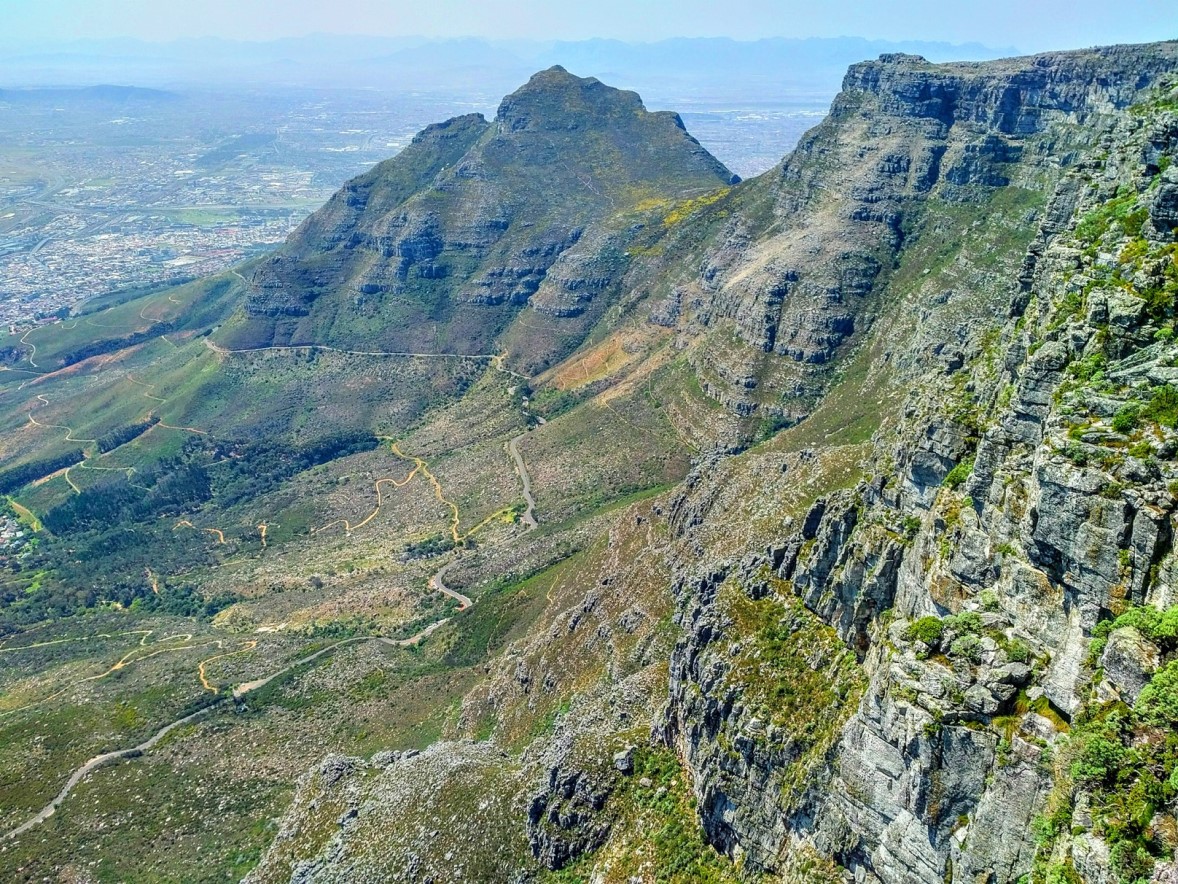
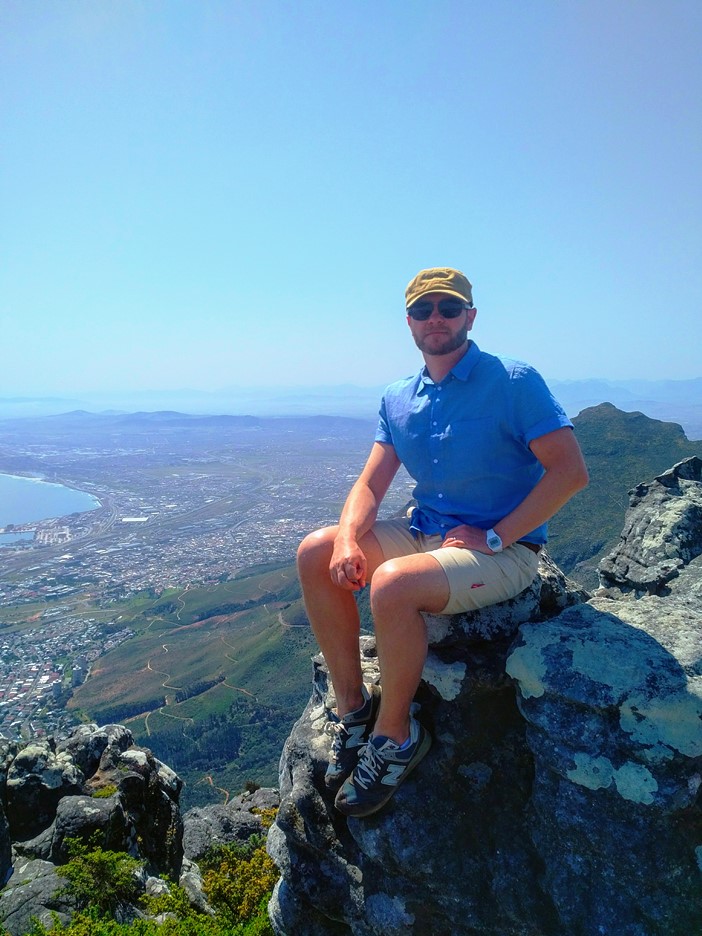
Overlooking Cape Town from the famed Table Mountain.


Lion's Head peak beyond the trees.

Colourful juxtaposition in the Bo-Kaap district of Cape Town. Formerly the Malay Township.
cape of good hope
Once we'd completed the inevitable and braced the swarms of tourists for our trip to the top of Table Mountain we began to look further afield and in doing so found ourselves in a taxi hurtling towards the famous Cape of Good Hope. A slight miscalculation meant that we'd drastically underestimated the distance between Cape Town and this, the most south westerly point of the African continent. Realising that we were unlikely to be able to procure another driver for the return journey we asked ours to stay on while we got out of the car and took the obligatory photos of this superlative bit of coastline and posed by the sign stating its continental significance. Our driver, Clive, got out too and used our visit as an opportunity to see the place for himself because, he revealed awkwardly, he'd never seen it before. The return trip was punctuated by sightings of ostriches on the beach and baboons crossing the road (road signs featuring a large exclamation mark warn of these cute but aggressive primates). A magical time was had at a beach called The Boulders - a wonderfully paradisal scene with azure waters lapping around giant grey stones in a setting the Caribbean would be proud of. It's also famously home to colonies of beautiful penguins perched on boulders, swimming out to sea, hiding in beach side bushes and waddling along the sand. Again, Clive waited for us but this time he stayed in the car (I'd like to think that he'd already been to this wonderful little spot). Boulders was another reminder, however, of how idiotic and destructive some humans are: breaking bushes to pry their lens at the penguins, unbelievably leaving their flash on and thus dazzling them and even shouting in the hope they'll look directly at the camera. A long drive back northwards to Cape Town saw us say farewell to Clive - an Uber driver who never expected such an adventure when he picked our job several hours previously and who declared, humorously, in an exhausted flounce that he was "going home" as we disembarked the car to mount the steps of our hotel. We all laughed and I gave him a pat on the back. It was a lovely end to a rather awesome day.
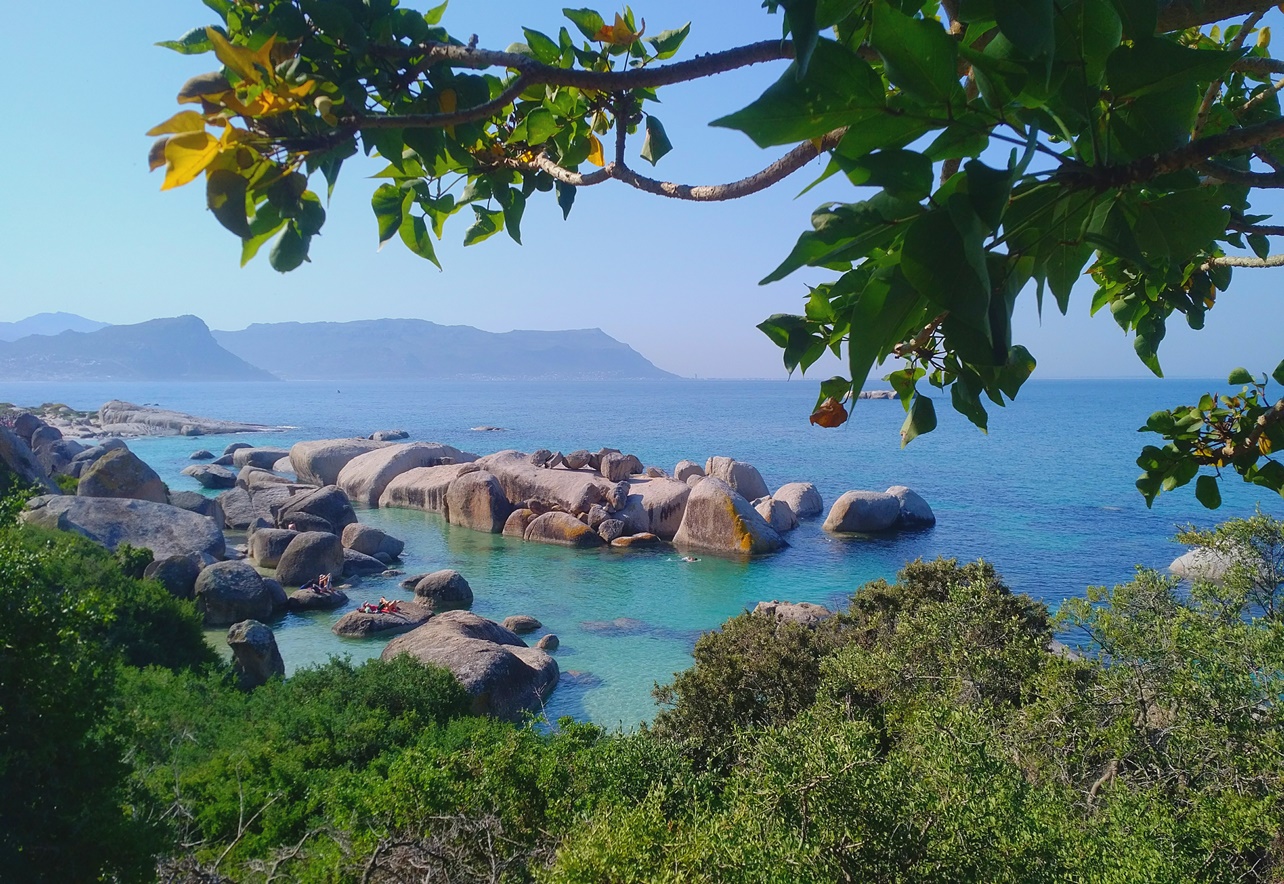

The Boulders Beach on the Western Cape of South Africa is home to colonies of adorable penguins.

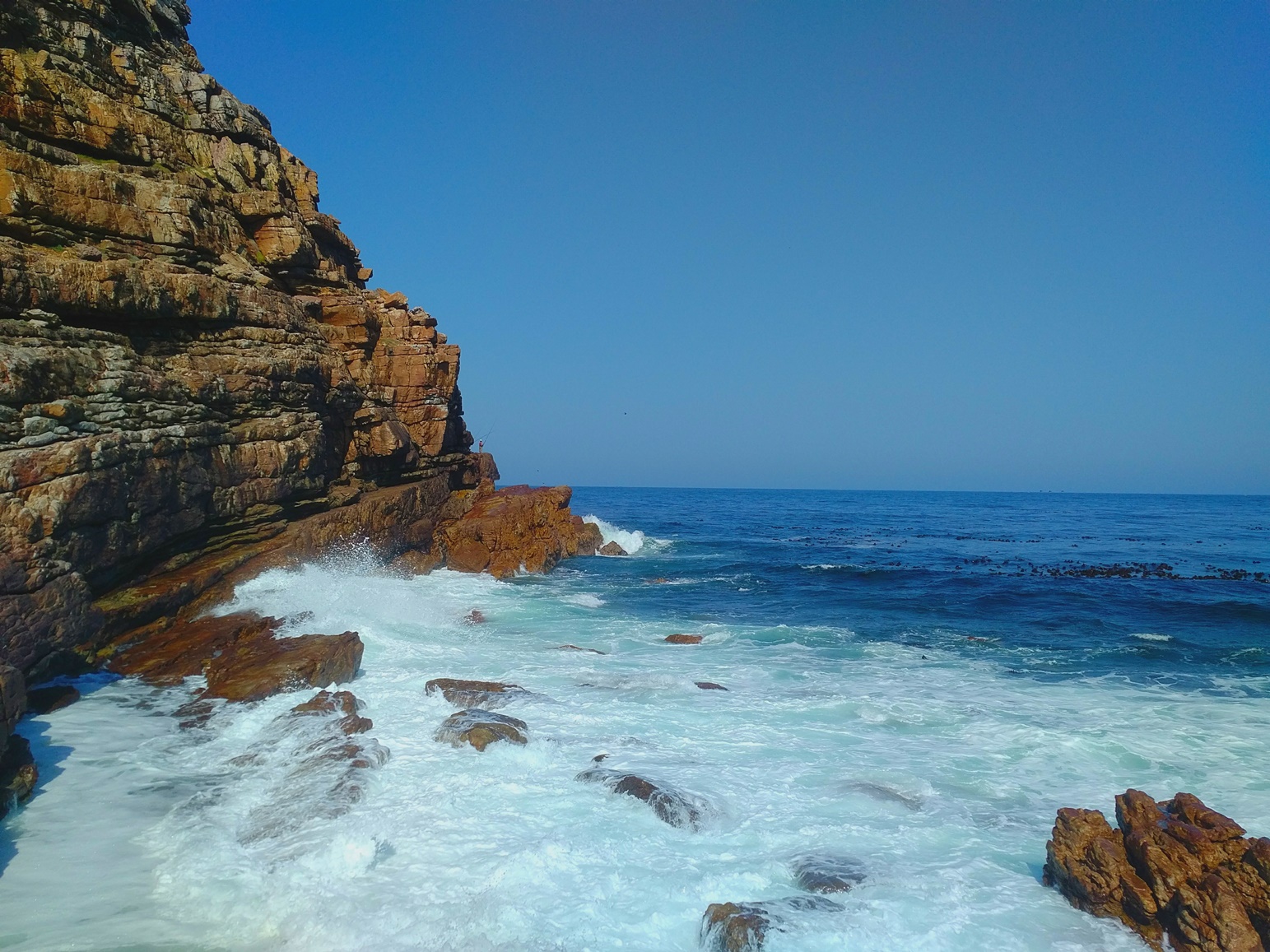
At the edge of of Africa: the most south-westerly point of the continent on the Cape of Good Hope.
lesotho
The Mountainous Kingdom in the Sky
Despite being fully enclaved by South Africa, and despite being only an hour's flight from Johannesburg, Lesotho feels very different. Indeed, I noticed this shift almost immediately after disembarking the plane. The feeling of walking on eggshells which I had back in South Africa, with tension always seeming to hover just below the surface, was replaced by a more easy going vibe, warm smiles and light laughter. Lesotho's marked contrast with South Africa is, in my opinion, reason enough for a visit to this miniature mountainous Kingdom in the Sky.
We arrived in Lesotho's capital Maseru, a tiny town comprised of small tin shacks of the poorest, most desperate kind. We'd touched down at its equally tiny international airport Moshoeshoe I, along with a contingent of United Nations staff visiting the country to advise the Lesotho government. Moshoeshoe receives only one inbound flight per day - and this was the one from Johannesburg which we had just disembarked. Despite its poverty, it was immediately noticeable from the air that Maseru's tin shack homes were not surrounded by barbed wire or electric fences. It was clear that the kind of vicious crime which gives parts of South Africa such a grisly, terrifying reputation did not apply here. I could feel myself relax - just a little. Lesotho's history is markedly different to that of South Africa. Like most it contains instances of war - but, importantly, not Apartheid and this undoubtedly accounts for the way you will feel and experience this little, lesser-visited, African gem. With the emphasis on the word kind, Lesotho is the kind of place where they ask you to sign a visitors' book as you arrive at the airport and where airport staff offer to lend you their pen so you can fill in the necessary arrival card. Another bonus of being so high up in the mountains also means you won't be needing any of your mosquito tablets here either! Lesotho, the self-billed mountainous "Kingdom in the Sky" , was my 84th country.
Street scene in Maseru, the capital of Lesotho. The mainstay of the economy are these roadside micro businesses, known locally as "tuck shops". I like this photograph; wherever I go in this world there always seems to be someone wearing a Manchester United top. I also like the cool dude's striking presence against a backdrop of corrugated tin.
Tsehlanyane
Tsehlanyane is a national park in Lesotho's far north with incredible views of the interlocking Drakensberg-Maloti mountain range and valleys full of boulders and the culturally important berg-bamboo. We stayed in a rondavel, a Western take on the traditional African round house, overlooking the valley where mountain peaks were regularly kissed and embraced by passing clouds. A seven kilometre hike through the mountains along the wonderfully-named Lets'a Lets'o trail, crossing small streams and some cute little mountain blooms, was an energising way to spend our first morning in what some describe as the "Rooftop of Africa". At 2080 metres above sea level I found myself short of breath far quicker than I would otherwise have been but brief stops along the route to compose shots of the very photogenic landscape helped to ease the additional strain brought on by the altitude. The ever-changing weather resulted in ever-changing mountain scenery: romantic pinks and pastels one day, cloudy and stormy the next, sleet and snow the next.
Without realising it, we found ourselves in Lesotho during its Independence Day celebrations, the country gaining its freedom from the British in 1966. What I assume were ordinarily sleepy rural villages now pumped to the sound of music; villagers wore their best clothes and donkeys carried crates of alcohol to their destination of consumption. Such Independence Day celebrations had the potential to curtail our plans to head out into village communities and see real Lesotho life outside of our privileged lodge ensconced high up in the mountains but, I am glad to say, there were people still willing to accommodate us on this most important of national holidays.
Our short trip around three village communities in the Maliba area included visiting a woman who was busy brewing and fermenting the local beer in large industrial barrels in her single room dwelling. As it was Independence Day I fear she was far busier than normal. Next door, in a similarly dismal space, was the local inn which consisted of an uneven compacted mud floor, four walls, a few plastic chairs and a small piece of wood strung up on the wall with a nearly spent candle on it "for when it gets dark in here", my guide remarked. Outside the inn a man, with few teeth remaining, swivelled around on his plastic chair like a naughty school child. To his right sat a woman in shabby clothing breastfeeding her child. I used the local word for "hello" which our guide had taught us just minutes before ("lumela") in a vain attempt to break the ice. This received a momentary smile from both of them before they resumed their apathy of us. We headed on up the road and were allowed to visit the home of an elderly deaf woman, who was sat outside her mud rondavel home in the sun, stewing cabbage. Our guide showed us inside: the hut was tiny and not unlike a scene out of Alice in Wonderland where everything seemed to be in miniature. To the left was a small single bed of the old-fashioned metal frame variety, straight ahead was a mud dresser which had been 'built' into the mud of the wall and housed a selection of carefully kept metal plates. Back outside and the cabbage, in its makeshift corrugated tin oven, bubbled ferociously. This wonderfully rural scene, with its mud homes set amid a green and red landscape and which looked out to snow-capped mountains pointing up into a bright blue sky, belied the poverty of the people living there. Never before on my travels have I deemed the uncouth phrase "dirt poor" to be so apt, with so many homes being constructed of the stuff. In Lesotho you glimpse abject poverty in its most confronting form but amid a setting of untrammelled beauty.
Our final stop was a visit to a third village and its local witch doctor (please note that I am using this term because it is that used by my guide and other locals). The rondavel in which she sat was even smaller, and was cut in half by a flowery-patterned bed sheet. What lay behind this makeshift curtain I could only guess, but in front of it, on the mud floor, sat a large woman wearing a red head dress. We were both beckoned to sit on a tiny bench where, I reasonably assumed, her patients propped themselves in their hour of need. Above her hung a modestly-sized animal skin with a curious assortment of disparate objects, including sticks with feathers, the horns of some unfortunate animal and other items which I could not readily identify. After a few awkward glances and broken conversation, our guide stated, "She is a doctor. She doesn't throw bones". I nodded in agreement not knowing what he meant. I still don't. After a quick exchange with a few local children outside, who were sat in a barrel full of straw giggling, our experience of real village life in Lesotho was over. As a traveller I am acutely aware of what has been termed "slum tourism" where rich camera lenses peer into the squalor of people living a third world existence. However, I take great comfort from the money each person described above received as a result of our visit - either in cold, hard notes deposited into their hands by our guide (or in the case of the witch doctor, into her bowl) or through the fee we had paid for the trip which went towards the Maliba Community Development Fund. I also sought permission each time I took a photograph of a person.
The scarcity of accommodation for visitors in Lesotho meant that after a wonderful two nights in a luxurious lodge overlooking the valley, a mountainous view which was blessed with snow on our second morning, we had no choice but to decamp to a budget rondavel hut down by the river. It was a dingy circular room with no heating and two bright white lightbulbs dangling from the straw ceiling. It was also home to a couple of spiders which I had no choice but to despatch quickly. It was an unappetising way to spend our final night in Lesotho but it was certainly a lot closer to an authentic experience of the country than our luxury lodge had ever been and so I valued it for this reason (and only this reason). I'd be lying if I said I didn't yearn for the creature comforts we'd enjoyed during the first two nights but I consoled myself with a two hour horse trek during the day so as to spend as little time in the riverside rondavel as possible. Also, our driver was to collect us at 5am in a bid to get us back to Moshoeshoe airport for our onward flight to Swaziland the following morning meaning we were, luckily, to spend even less time in the dingy rondavel.
In my heart I waved goodbye to Lesotho's majestic mountains as we headed out in the morning darkness and on to yet another southern Africa country about which I knew very little but hoped to discover much.

Lesotho is billed as the "Kingdom in the Sky" and this photograph is part justification for this hyperbolic description.

Beautiful mountainous Lesotho - the view from our mountain lodge overlooking the valley at 2200 metres above sea level.
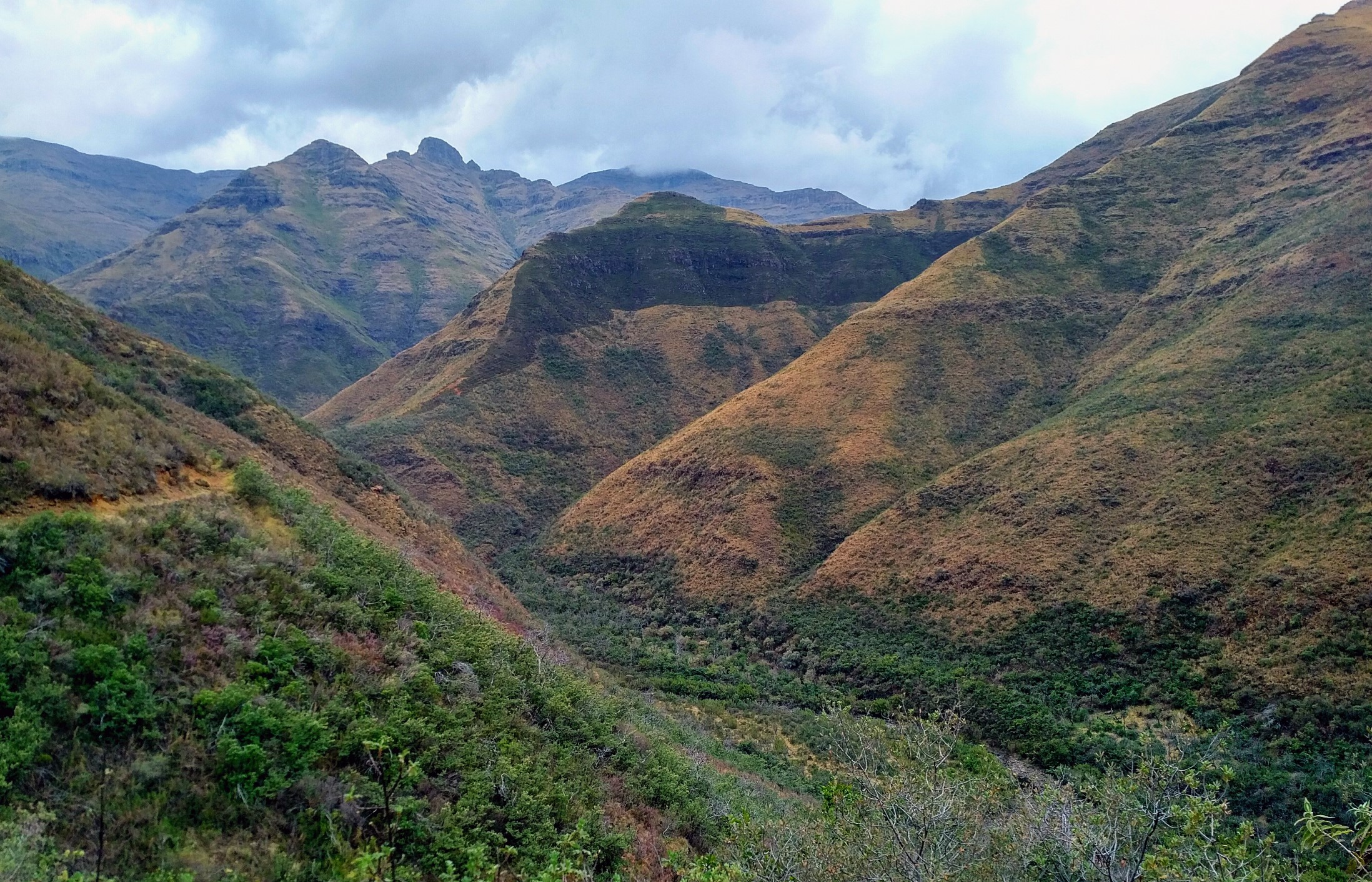
A 7 kilometre trek through the mountains along the Lets'a Lets'o hiking trail, crossing small streams and some cute little mountain blooms.

A 7 kilometre trek along the Lets'a Lets'o hiking trail.At 2080 metres above sea level I found myself a little short of breath.
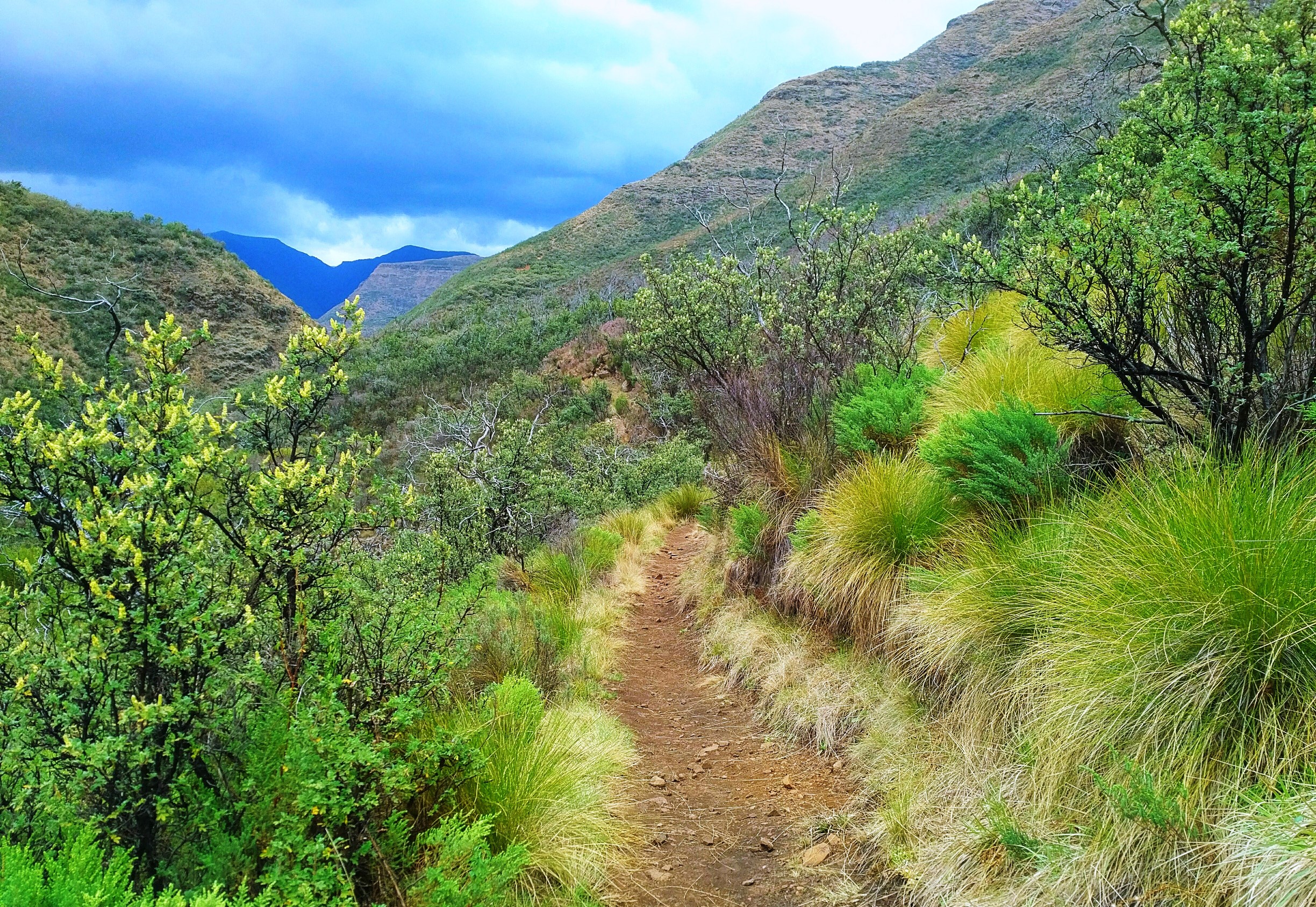
The Lets'a Lets'o hiking trail is a trek where you move through a shifting landscape. Part way through and you enter luscious green.
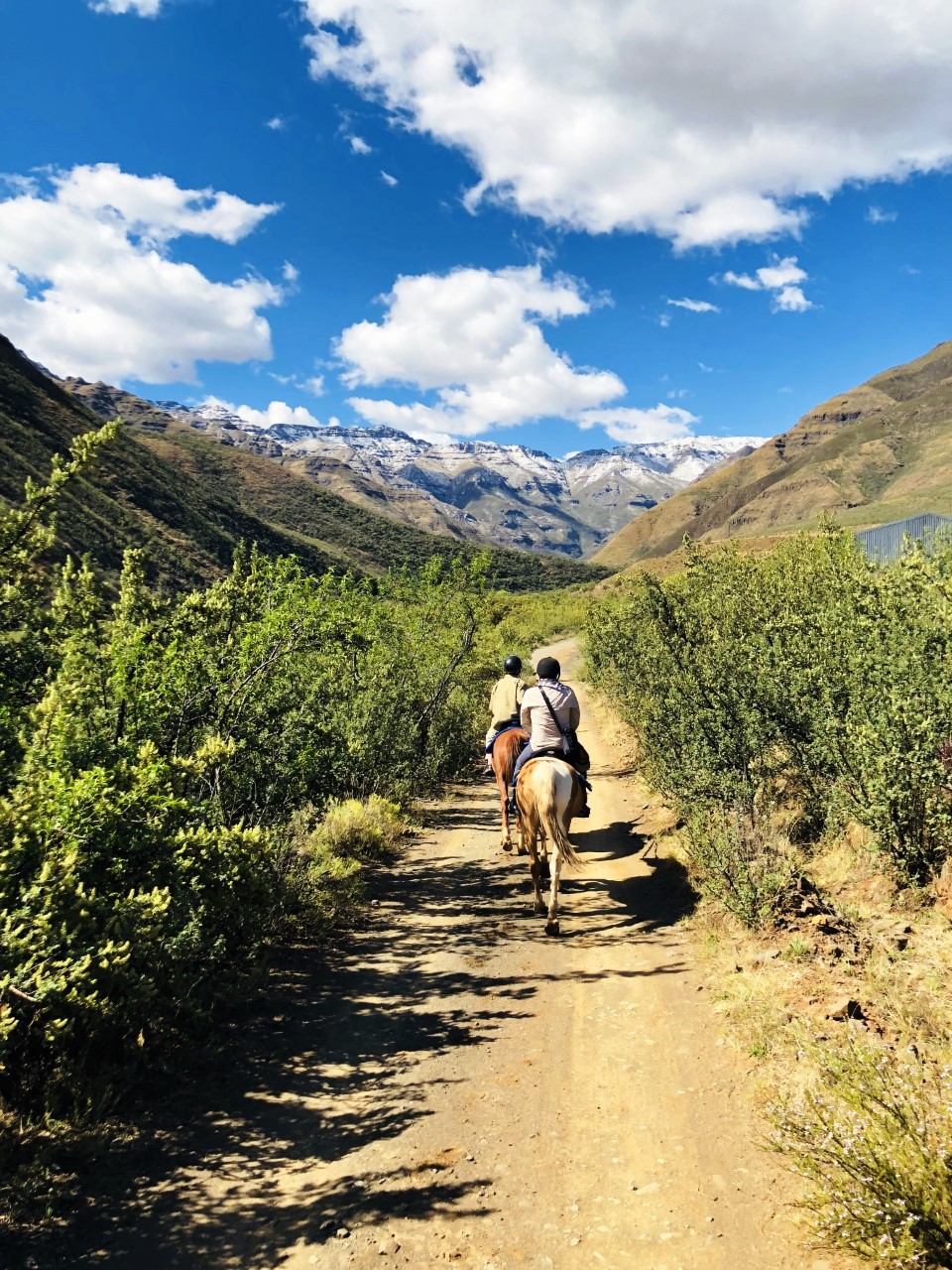
Horse trekking with a view in Tsehlanyane.

A donkey carries bottles of the local brew down the hill to waiting villagers on Independence Day.

A local woman cooks cabbage outside her rondavel mud hut amid a picture postcard setting.

The local witch doctor for a small village near Maliba. Some charms hang behind her on an animal skin.

A row of traditional rondavel huts, one of which was our home for a couple of nights.
swaziland | eswatini
The World's Last Absolute Monarchy
Swaziland, a little smaller than the size of Wales, gained full independence from the British in 1968 and is now the world's last remaining absolute monarchy. This means that King Mswati III makes all of the decisions in this Lilliputian country on South Africa's eastern border. The Queen Mother Ntombe acts in the role of chief consultant and adviser; no decision can be made without consulting her first. No doubt she would have been consulted about the country's name change from Swaziland to Eswatini. In fact, this is not a name change as such, merely a restoration of the original; the name "Swaziland" was a British colonial invention. I have decided to refer to Swaziland in this Chronicle rather than Eswatini simply because it is the name that, at time of writing, many will recognise the country by. Additionally, the name Swaziland is still very much used by locals and officials alike. Finally, I couldn't help but notice that the country's circular stamp in my passport emphatically declares that I have entered "SWAZILAND" and not Eswatini. If Swaziland is good enough for my passport, it's good enough for this Chronicle.
Swaziland is opening up to the world and looking for foreign investment - and this is no more apparent than the newly opened King Mswati III international airport. Its large size is more than is currently required to service passengers for the grand total of two flights per day - and that's because this is a country looking to the future with a keen eye on growth and prosperity. Indeed, investment is trickling in from countries like China keen to strengthen its hold on Africa as part of its Belt and Road project. As with many autocratic rulers, the King of Swaziland no doubt realises that opportunities, investment and modernisation are essential to avoid an existential threat to what is arguably a very outmoded style of governance.
Arriving at this airport was a surreal experience. Our plane had seating for 45 but only 15 were taken. I couldn't help but notice that our aircraft was the only one in the entire airport. There weren't even any parked up. It was completely deserted. A trip to Swaziland is without doubt travel off the beaten track. I braced myself as I entered my 85th country... and was quickly greeted by a group of government workers proffering bananas, nuts and mango juice as I waited to collect my backpack from the luggage conveyor belt. I am still unsure as to the real purpose of their jamboree but it heralded an unmistakable contrast with the tension of South Africa and the softer, easy-going atmosphere of Lesotho. I told you this journey was characterised by few similarities and many contrasts...
ezulwini & manzini
In stark contrast to Lesotho Swaziland looked positively affluent. Gone were the gravity-defying tin shacks by every roadside at perpetual risk of being blown away by the lightest puff of wind, replaced by far more respectable brick dwellings. Things felt ordered, tidy, peaceful.
We had managed to procure the services of a local Swazi guy passionate about his country and its promising future now symbolised by the cranes and building work going on in his country. Lucky, his tourist-friendly name, was a contact from our guide in Lesotho and was just as keen as I was to take photographs of this very photogenic country. Our time in Swaziland was extremely limited and so we booked Lucky for a day to drive us around the western side of the country, taking in a colourful local craft market (selling excellent quality crafts I might add), the world's oldest mine, incredible views from western Swaziland at Ngwenya towards South Africa (indeed, we were so close to South Africa that my mobile phone began connecting to a South African service provider rather than a Swazi one), and the Ngwenya glass factory which was also home to some fascinating Weaver Birds spinning their upside-down nests before my very eyes in a tree outside. I also requested a stop outside the Nazarene University near the city of Manzini where I had spotted some evocative Swazi-inspired murals the previous day. The fresh sunny morning soon slipped into something a little more humid and uncomfortable, and with such little time available to see this rather great country, it was a great day just letting Lucky take the strain. Lucky's choice of in-car music came in the form of Tracy Chapman and a local artist called Bholoja - music which all three of us enjoyed and which quickly became the soothing soundtrack to our time in Swaziland.
We stayed in the Mantenga area of Swaziland, our lodge coming with a dramatic view of the infamous Execution Rock. The restaurant terrace was regularly the stage for skirmishes between naughty Vervet Monkeys who would swing down from trees in a bid to steal whatever they could and lodge staff using home-made catapults to scare them away. One evening we walked down to Mantenga village, nestled in the Ezulwini Valley, to experience what every traveller comes to this place for: the mesmerising Swazi dancers who, in traditional cultural dress dance, sing, beat drums and blow horns. Disconcertingly our descent down into the valley passed a number of "Beware Crocodile" signs and so, on our return journey we cheekily flagged down a passing pick-up truck, driven by staff of the Swaziland National Parks department, who were more than happy for us to sit in the tray at the back and whizz us to the top of the hill.
Swaziland was a pleasant surprise and so unlike South Africa and Lesotho before it. It was a land full of character and stylish cool, a land of vivid cultural colour firmly looking to the future. I just hope that in its race to develop and modernise it doesn't sell out to China and lose those things which make it special.
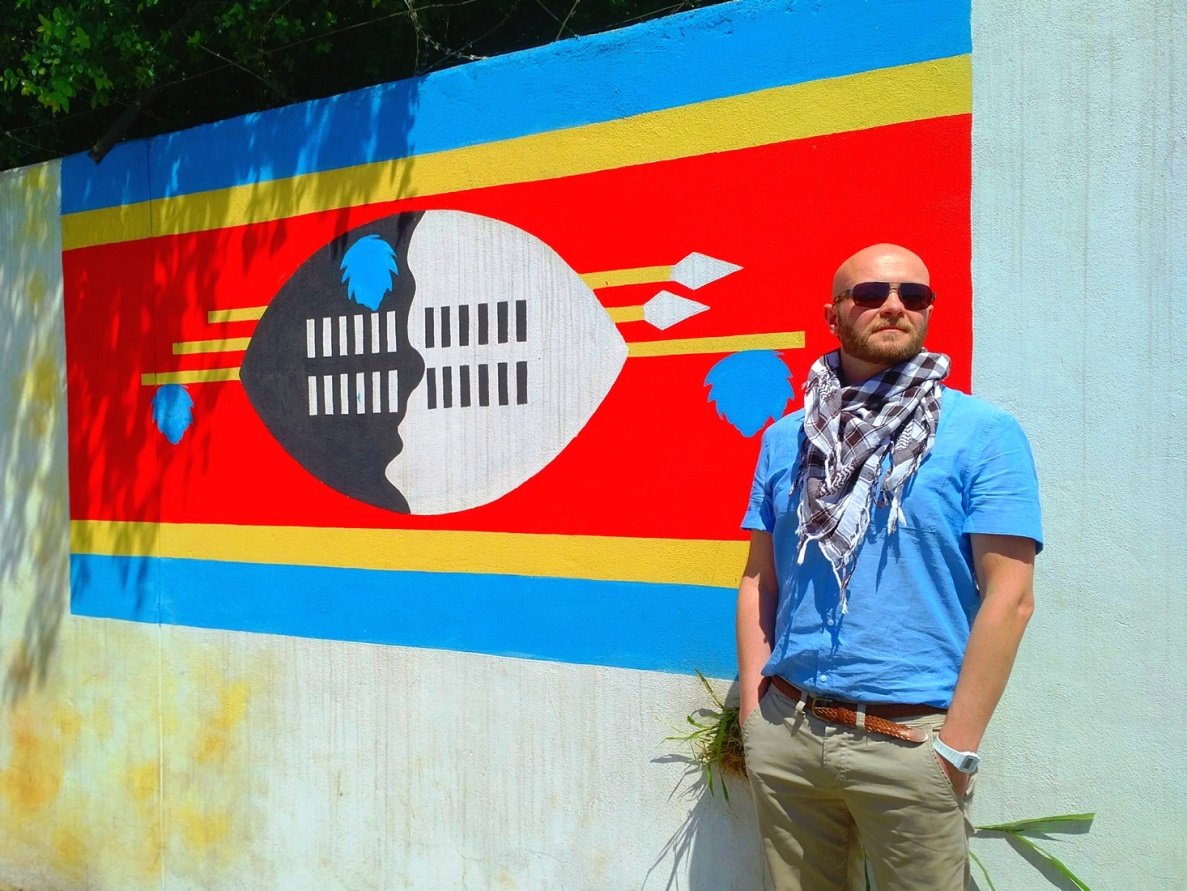
In front of the Swaziland flag. The black and white shield represents racial harmony. Also, the blue represents the sky, the yellow depicts mineral wealth and the red symbolises the rich fertile earth of Swaziland. So many national flags feel generic and devoid of a sense of place. I love the Swazi flag; it speaks so much of place.
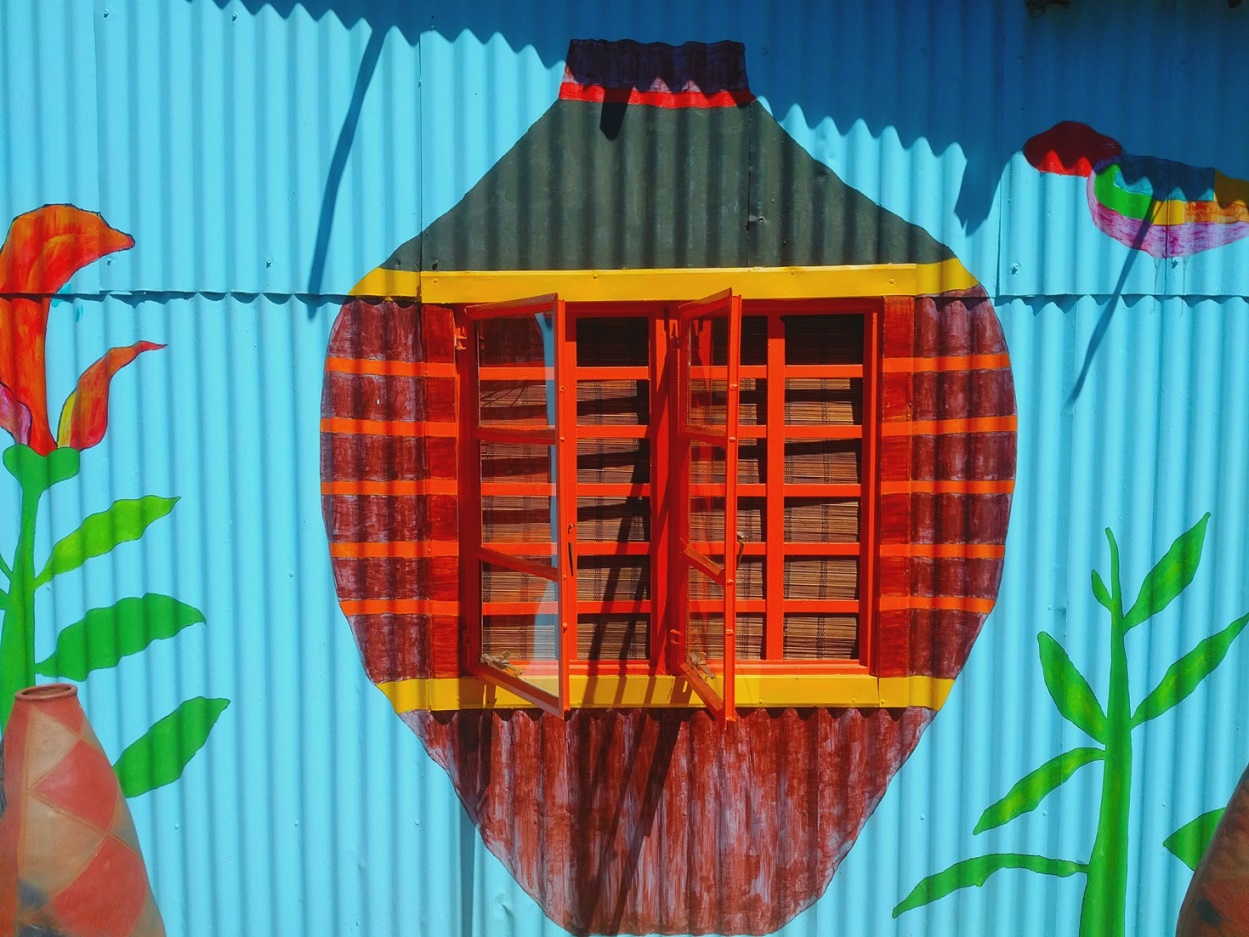
A characterful window in Mbabane which speaks so much of Africa.
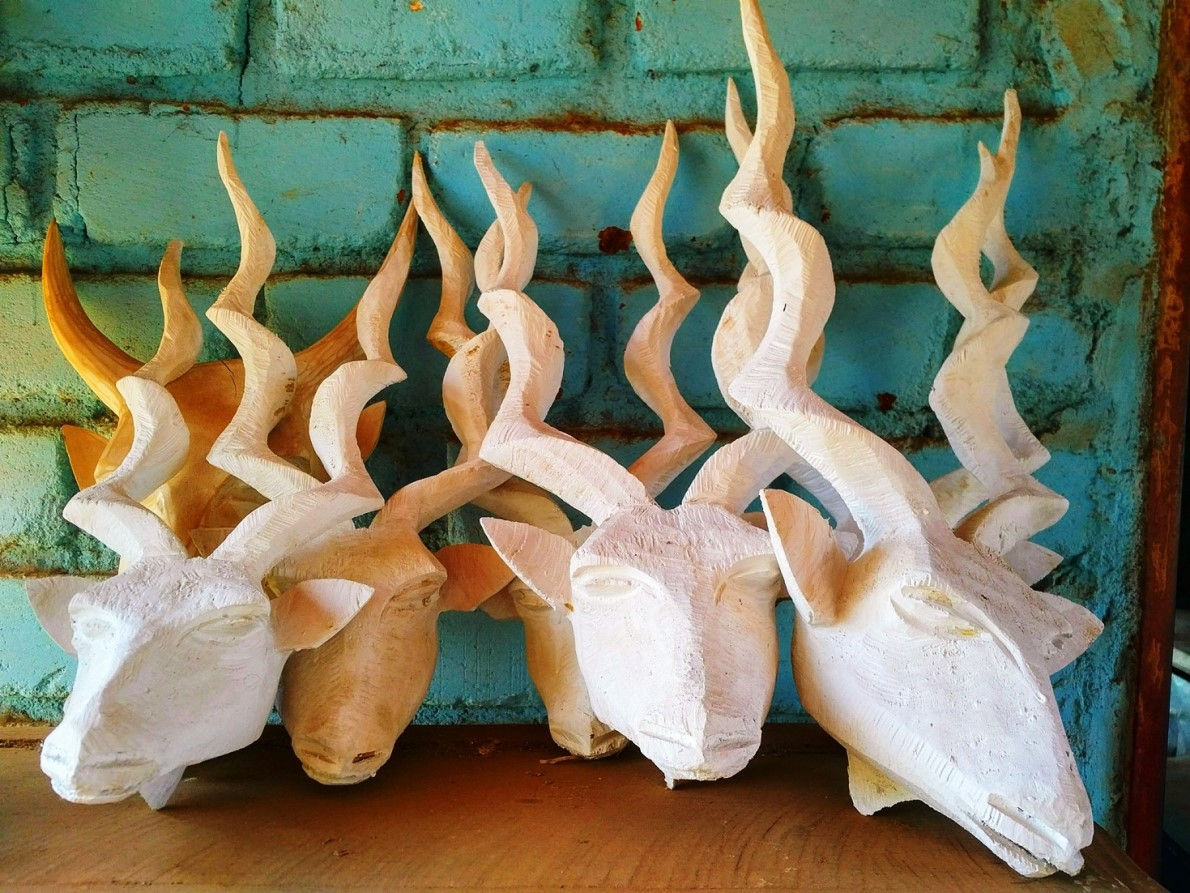
Male antelope heads in the workshop ready for final finishing and sale.
A Vervet Monkey looks particularly mischievous in Ezulwini Valley.
A Weaver Bird at Ngwenya.
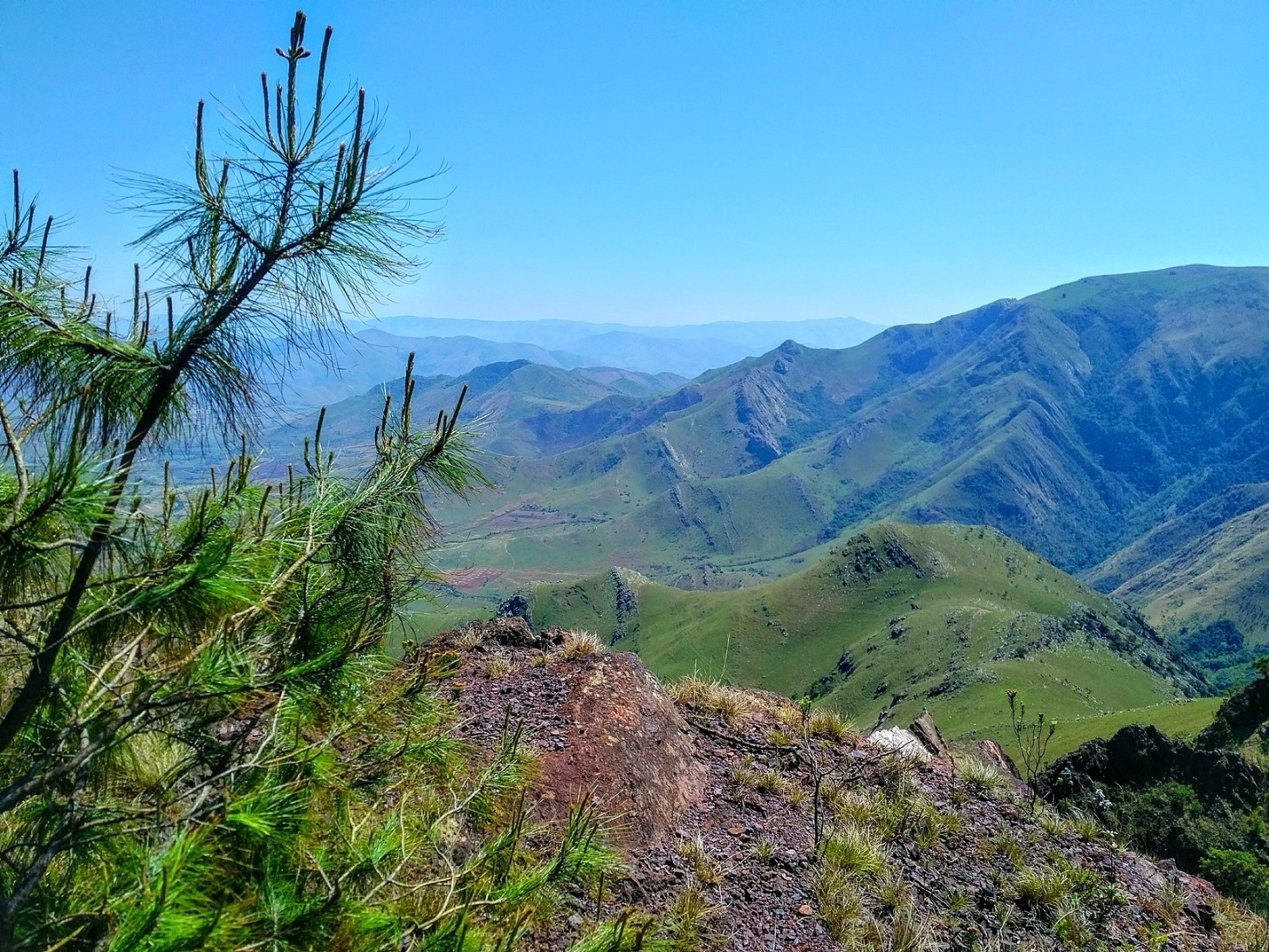
Swaziland has some amazing vistas. This is the view from Ngwenya and out towards Swaziland's border with South Africa.
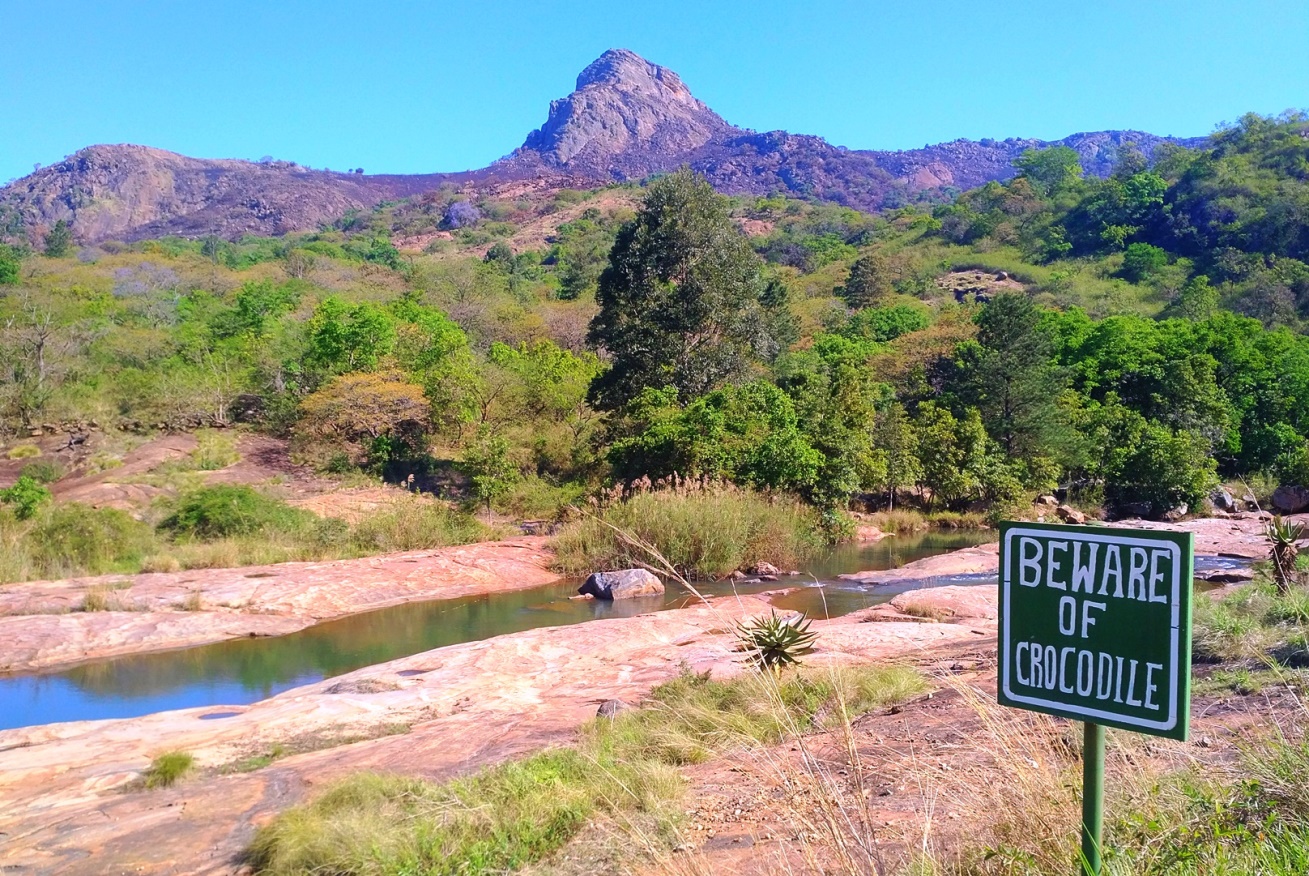
Our 3 kilometre walk down to Mantenga village had this sign along the way. We thought it was a joke, but then there was another. On our return I asked the guard. "It's okay, we haven't seen one for a while." That's okay, then.
An incredible traditional Swazi performance at Mantenga village. The motion, singing and drumming were mesmerising and almost hypnotic.
travel tips, links & resources
- Air travel around Africa is particularly problematic. At the southern tip of this vast continent airport hubs are few and far between meaning that, if like us, you want to fly to neighbouring countries to save time, your only option is to fly in and out of Johannesburg in South Africa. Africa is not as connected as other parts of the world which means that getting places to explore properly is a frustrating, time consuming and expensive experience.
- The airline market in this part of the world lacks the one thing which helps to keep prices down: competition. Thus you'll find that air fares are unreasonably priced considering the flight time and distance travelled. It's just one of those things. When planning this three country adventure it was clear that prices were fixed and did not increase or decrease over time. There's nothing to be had, therefore, of trying to book early as the prices are likely to be the same.
- In lesser-travelled countries like Lesotho and Swaziland it pays to book ahead for accommodation. Hotels and home stays are booked up months in advance. Plan early if you want to secure a bed in some of the more sought-after establishments.
- When travelling to Africa and other Malarial areas of the world, check the useful Malaria Map.
- The status quo in this part of the world seems to be self-drive tourism. We were really unusual in that we did not hire a car to travel from the airports out to our lodges (some many hours away). This meant that we had real trouble arranging airport pick-ups - something I've come to expect as standard in almost every other place I've been to (a little luxury I afford myself). Do your research early and give your hotel plenty of time to arrange a transfer or you could be left standing. The airport in Lesotho at time of visiting had no taxi rank.
- Lesotho's mountainous location means that the weather is highly changeable. During our short time it went from very warm with clear blue skies, to dramatic thunder and lightning storms and then snow. Pack with this changeability in mind.
- For travel around Swaziland we booked Nhlanhla Mavuso (Lucky). For our travel around Lesotho we used Leseli Tours. Both were excellent.
- Travel to Table Mountain in Cape Town as soon as you can or as soon as the clouds clear. It could be days before the clouds clear again.
- Purchase your tickets online for Table Mountain. This will save you from having to queue. Similarly, if you want to go to Mandela's prison cell on Robben Island, book well ahead. Everything was fully booked by the time we'd arrived and so had to forgo this opportunity.
you may also like
